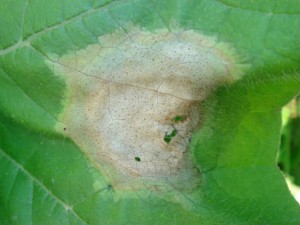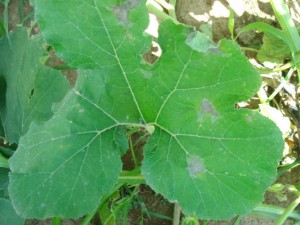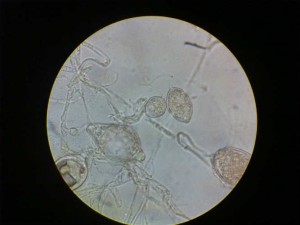What Is It? | Facts in Depth | For the Professional Diagnostician
Cucurbit Diseases | Phytophthora Blight
Phytophthora Blight
Symptoms
Seedlings:
- In seedlings, tan-brown, watery, soft rot of roots and crown.
Roots:
- Roots exhibit a tan-brown, watery, soft rot. The rotted cortex can be pulled easily from the root stele.
Stems and Vines:
- Watersoaked lesions form on stems and vines that become brown and may girdle the stem and vines. A lesion is most often found on the crown and extends up past the soil line.
Leaves:
- Foliage wilts rapidly even with sufficient water. Lesions begin as chlorotic leaf areas that become brown and necrotic. Under disease conducive conditions, lesions expand and coalesce and may kill the entire leaf.



Foliar symptoms on cucumber plants (left) and pumpkin leaves (middle and right).
Fruits:
- Circular to irregularly shaped, watersoaked areas become slightly darkened and sunken and expand under disease conducive conditions. Fruit becomes covered in white, velvety sporulation. A tape mount of this sporulating area can quickly be checked to determine the presence of P. capsici.



Symptoms of Phythophthora blight on cucumber (left), pumpkin (middle), and winter squash (right).
Signs
Mycelia are coenocytic. Papillate, caducous sporangia are 33-66 μm long and 17-39 μm wide and often have long pedicels. Oospores (plerotic) are only seen in the presence of both mating types (antheridia amphigynous) and are 23-50 μm in diameter. Help with identifying Phytophthora species can be found in the book Phytophthora: Identifying species by Morphology and DNA Fingerprints or on the website Phytophthora-ID.



Often Confused With
- Damping off: Check roots microscopically for signs of other fungal or oomycete pathogens. Culturing may be necessary to identify the pathogen.
- Anthracnose: Check fruits for pink sporulation under high humidity. Leaf and stem lesions are smaller than Phytophthora blight lesions.
- Bacterial wilt: Slowly pull apart fresh cut stem to look for sticky strands of bacteria. There is no root discoloration associated with bacterial wilt.
- Fusarium wilt: Check for vascular discoloration in root and crown tissues. Rotted cortex cannot be easily pulled from stele.
- Bacterial fruit blotch: Fruit will not sporulate when placed under high humidity.
Isolation Media
Rapid Diagnostic Tests
- Genus-specific ELISA and lateral flow devices are available for Phytophthora.
- Species Specific PCR
- Silvar, C., Duncan, J.M., Cooke, D.E.L., Williams, N.A., Diaz, J., Merino, F. 2005. Development of specific PCR primers for identification and detection of Phytophthora capsici Leon. European Journal of Plant Pathology 112:43-52.
- CAPFW 5’ TTTAGTTGGGGGTCTTGTACC 3’
- CAPRV1 5’ CCTCCACAACCAGCAACA 3’ (452 bp with CAPFW)
- CAPRV2 5’ TACGGTTCACCAGCCCATCA3’ (595 bp with CAPFW)
- Silvar, C., Duncan, J.M., Cooke, D.E.L., Williams, N.A., Diaz, J., Merino, F. 2005. Development of specific PCR primers for identification and detection of Phytophthora capsici Leon. European Journal of Plant Pathology 112:43-52.
